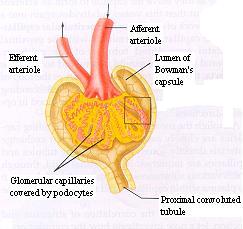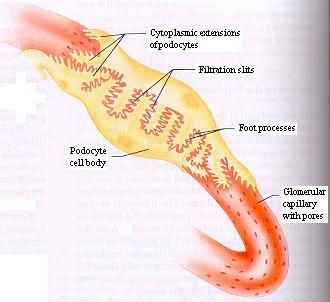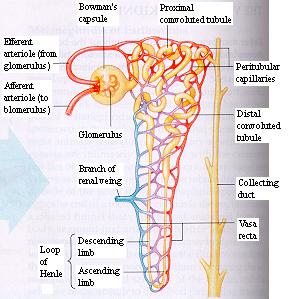





Each kidney in a human contains about a million nephrons. These nephrons make the actual changes to the blood composition.

There are two types of nephron: cortical nephron and juxtamedullary nephron. The main difference in the two types of nephron is the length to which the loop of Henle extends into the kidney. Cortical nephron, which are about eighty percent of the nephron in humans, have a loop of Henle that does not extend past the cortex of the kidney. Juxtamedullary nephron, on the other hand, have a loop of Henle that extends past the cortex and into the medulla of the kidney.

Blood arrives to the nephron due to the afferent arteriole. This arteriole then divides into a mass of capillaries, called the glomerulus. The capillaries of the glomerulus surrounded by the Bowman's capsule, the cup-shaped end of the renal tubule.
Click to see picture of glomerulus

In the Bowman's capsule, components of the blood, such as water, urea, salts, and other small molecules, are filtered out into the Bowman's capsule by podocytes, but not the blood itself. The result is the accumulation of filtrate in the renal tubule. The process is called filtration.
Click to see picture of podocyte

Filtrate, as it leaves the Bowman's capsule, goes through the proximal convoluted tubule. In this region water, salt, glucose, and potassium are reabsorbed. Hydrogen ions and ammonia are also secreted into the tubule. This region is important for the controlling of blood pH.
Next, in the descendig limb of the loop of Henle, more water is passively reabsorbed into the medulla. As the loop turns back up, salt is first passively and then actively reabsorbed from the ascending limb of the loop of Henle.
In the distal convoluted tubule sodium ions, bicarbonate, and even more water are reabsorbed into the cortex. Potassium ions and hydrogen ions are secreted into the filtrate. Then as the filtrate flows down the collecting duct, water and urea are reabsorbed into the inner medulla.
As the filtrate moves through the renal tubule, the osmolarity of the filtrate changes. As it moves deeper into the medulla, it increases, and when it ascends the loop of Henle, it decreases only to increase again while going down the collecting duct. It is this hyperosmotic condition in the medulla that allows passive transport to occur.